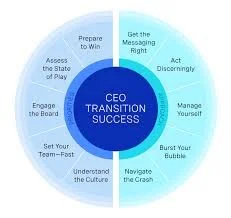The New CEO | Book Review
“When you're new to the CEO role, you will need to
first assess your organization's culture and then
decide what you want it to be." (p. 207)
Subtitled Lessons from CEOs on How to Start Well and Perform Quickly (minus the common mistakes) by Ty Wiggins, Ph. D. with Justus O'Brien, Laura Sanderson, Margot McShane, Rusty O'Kelley and Stephen Langton, intentionally focuses on the when and how CEOs should begin their new role (p. 10). It's worth reading Chapter 11, If I Could Do It All Over Again, first, capturing summary thoughts of numerous interviewed Chief Executive Officers. This review modestly suggests that perhaps Vison and Strategy do inform what new CEOs do, and why they do it.
In The Knowing Doing Gap, Pfeffer and Sutton significantly note (p. 22) when benchmarking other organizations, most companies:
“overestimate the importance of the tangible, specific, programmatic
aspects of what competitors, for instance, do, and underestimate the
importance of the underlying philosophy that guides what they do
and why they do it.”
Jim Collins sets up a hierarchy in BE 2.0:
and further defines Core Ideology (see Built to Last) as Purpose (Fundamental reason for existence) + Core Values (Expectations for personal behavior). Combining the two, Vision is then Core Ideology + Mission. We may also recall from Collins that an organization's purpose may change, but values are more fundamental and do not. Note that tactics follow vision and strategy.
CEO Lyssa McGowan summarizes her role:
"It was about communicating the vision for the future." (p. 45).
Wiggins' CEO Transition Success (p. 6) defines a new CEO's approach on the right, and initial priorities on the left. These ten steps outline the book.
Interestingly, the authors found when asking more than 200 CEOs globally about the things that only the CEO can or should do, they listed culture, communication, working with the board, and also vision and strategy (p. 126). Specifically, CEO Carol Tomé offers:
"I hoped to inspire around a shared purpose." (p. 153).
Two takeaways: The top regret I hear from new CEOs is that thy wish they had moved faster on their teams (p. 9). The second-most common regret from CEO, was wishing they had better engaged their board earlier (p. 9).
Approach
Humility and clarity are common to many approaches, perhaps best captured in a new CEO's Personal Leadership Philosophy, or PLP. CEO Ramon Laguarta's shares "It means you need to be curious to ensure you learn what is really happening." (p. 62) The authors seem to agree we should initially ask why:
You need to learn and to understand the business,
not look for things that confirm what you thought going in. (p. 71)
Wiggins calls out Satya Nadella, Microsoft's third CEO, who in just a little over 1,000 words, he unflinchingly set out who he was, why he was there, and what the company would do next (p. 92) -- or in essence his leadership philosophy.
Alignment is also key. One important step is to make sure you are clear about your priorities and what success looks like from the board's perspective (p. 117).
Priorities
In our Leader's Compass workshop, we stress the value of creating a leadership philosophy before we're in a leader role. If you don't leverage the time before you start, it will be harder for you to perform as fast or as well as expected (p. 36). Exactly what Carol Tomé of UPS did. What Carol did so well was to establish new and clear ground rules for how her top team would operate, almost from Day One (p. 155). She set expectations.
Sanjiv Lamba, of Linde, plc did the same: I doubled down on the communication ensuring every employee understood our priorities and why we made the decision we did (p. 42).
Numerous CEOs interviewed adopted the role of leader as coach. As CEO, your role is to create the environment where the relevant leaders with the expertise, knowledge, and understanding can help you make the best decisions (p. 167). A good performance coach understands the abilities of others and continuously aligns the team. Take time to understand individual director's views on the company, culture, top team, and opportunities, as well as what they believe the board's role is for the organization (p. 181).
CEO Doug Mack (Fanatics) "To me, being a CEO is all about being the coach of a team of elite players." (p. 135)
Summary
Marc Bitzer (Whirlpool), summarizes the approach well:
Never forget that you are here to serve. Serve the organization first,
then your team, and long afterward yourself. (p. 223)
Thank you JL Bielon, for introducing the book.
JE | April 2025



